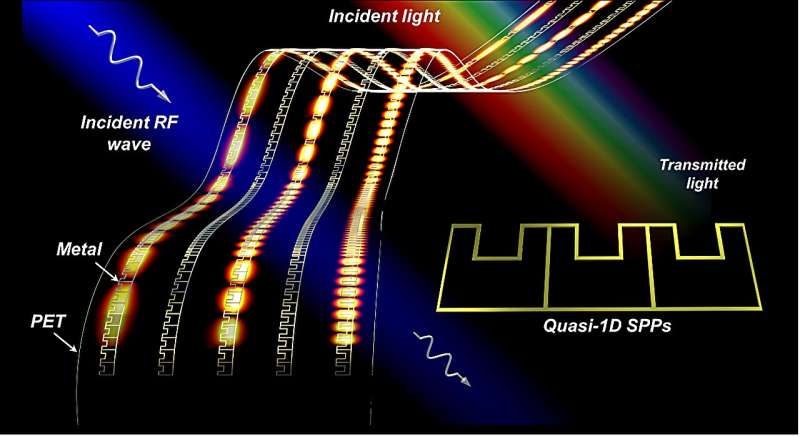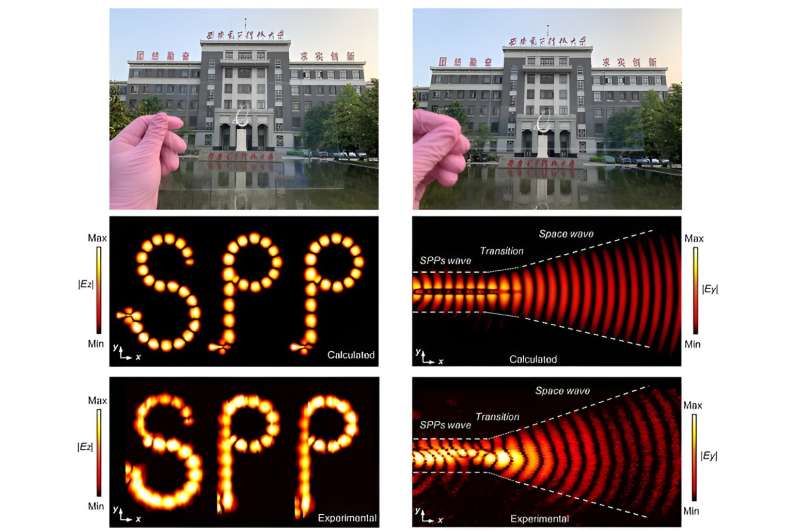August 2, 2023 feature
This article has been reviewed according to Science X's editorial process and policies. Editors have highlighted the following attributes while ensuring the content's credibility:
fact-checked
peer-reviewed publication
trusted source
proofread
New transparent metadevices based on quasi-1D surface plasmon polariton structures

Transparent electronic devices could have numerous valuable real-world applications. Among other things, they could enable the creation of new optical devices, smart gear or wearables, invisible solar panels and integrated communication systems.
Researchers at Xidian University, Southeast University and Wuhan University of Technology recently developed new, highly promising, transparent metadevices based on quasi-one-dimensional surface plasmon polariton (quasi-1D SPP) structures. These devices, introduced in a paper published in Nature Electronics, could be used to develop optically and radiofrequency transparent wireless communication systems and other promising technologies.
"Transparent and invisible electronic device is a fascinating goal that scientists and engineers are enthusiastically pursuing," Prof. Bian Wu, one of the researchers who carried out the study, told Tech Xplore. "Currently, transparent electronics typically rely on the intrinsic properties of optically conductive materials, which are not radiofrequency transparent and have low operating efficiency. SSPs can be used to concentrate, channel and enhance energy. However, the use of SPPs in the development of optical and radiofrequency transparency remains blank."
The primary objective of the recent work by Prof. Wu and his colleagues was to fabricate new metadevices (i.e., devices based on metamaterials) that were transparent both at an optical (i.e., visual) and radio-frequency level. The devices they fabricated are based on quasi-1D SSPs (i.e., highly confined electromagnetic surface waves traveling at the interface between a dielectric and a metal) using q fine metallic lines, which is much different from the conventional SPPs devices in their previous works..
"We utilize quasi-1D SPP structures to realize optical and RF transparency electronics, regardless of whether the conductor material is transparent or not, let alone the preparation of expensive transparent conductor materials," Prof. Wu explained. "Our quasi-1D SPPs structure, composed of subwavelength unit cells created from fine metallic lines, can provide confined SPPs waves while offering optical and radiofrequency transmittance more than 90%."

The approach that the researchers employed to create their metadevices has several advantages. Notably, it can produce arbitrarily-shaped waveguides with a great topological robustness and converters that can transform SPP waves into so-called space waves (i.e., radio waves that can be propagated in space, for instance if transmitted by an antenna or other devices).
"For the first time, we have realized optical and radiofrequency transparency metadevices based on quasi-1D SPP structures," Prof. Wu said. "We used the approach to create 'SPP'-shaped waveguides with topological robustness and converters for turning SPPs waves into space waves, and also used the quasi-1D SPP metadevices to create a wireless communication scheme for image transfer. Our technology breaks through the optical and RF transmittance limit of transparent electromagnetic devices."
To demonstrate the potential of their transparent metadevices, Prof. Wu and his colleagues have used them to create a wireless communication scheme. They then successfully used this scheme to transfer images from one quasi-1D SPPs based metadevice to another.
In the future, their work could contribute to the development of new light transmission and radio frequency stealth wireless transmission systems for 5G or even 6G communication. In addition, it could help to meet the demands of Internet of Things (IoT) applications, smart home systems, connected vehicles and other systems that rely on good wireless communication.
"In our next studies, we plan to develop systematic applications of this technology, including various kinds of transparent antennas and transparent microwave devices based on quasi-1D SPP structures, and integrate them with objects in our lives to create an era of imperceptible interconnection of things," Prof. Wu added.
More information: Hao-Ran Zu et al, Optically and radiofrequency-transparent metadevices based on quasi-one-dimensional surface plasmon polariton structures, Nature Electronics (2023). DOI: 10.1038/s41928-023-00995-z
© 2023 Science X Network

















